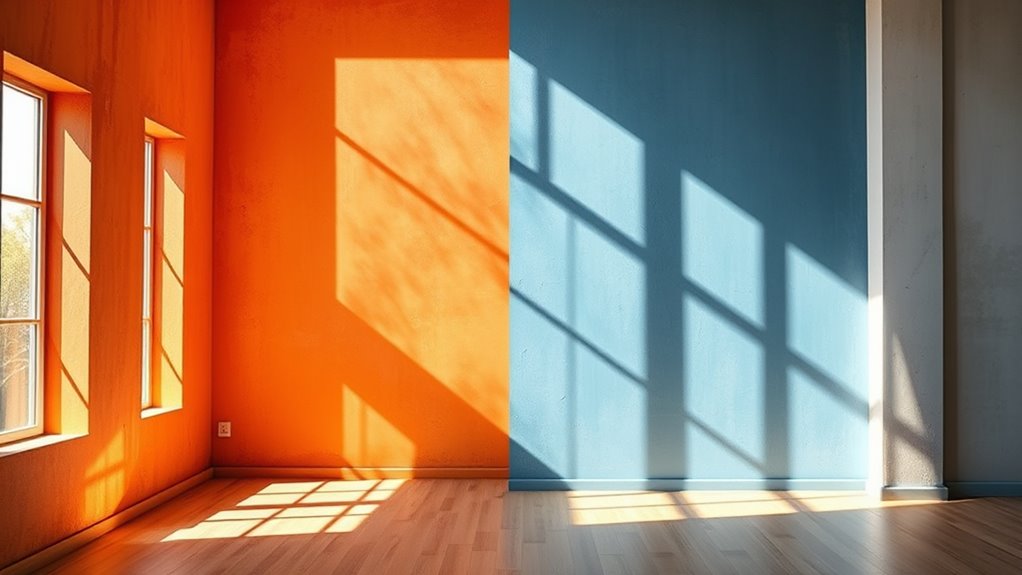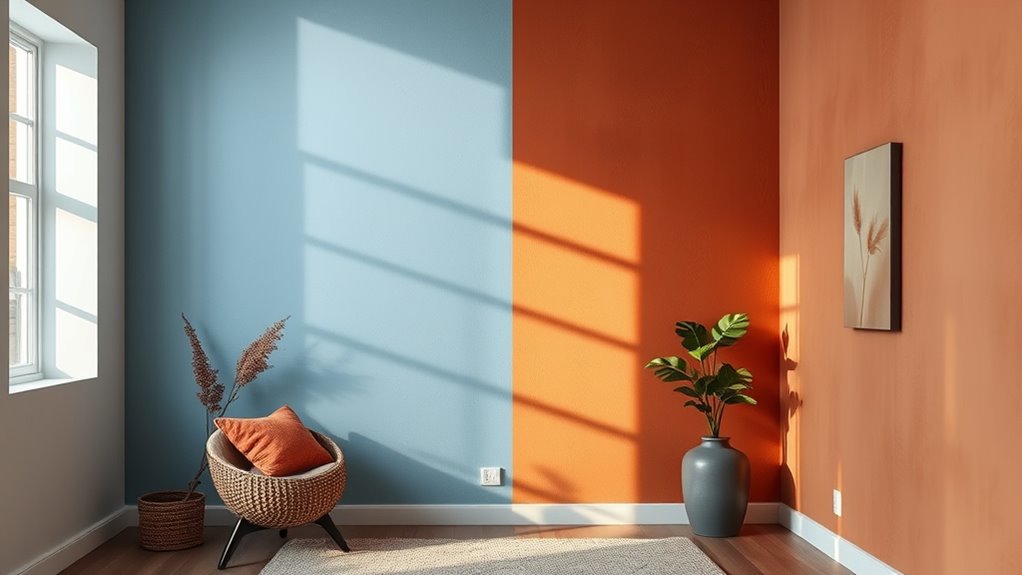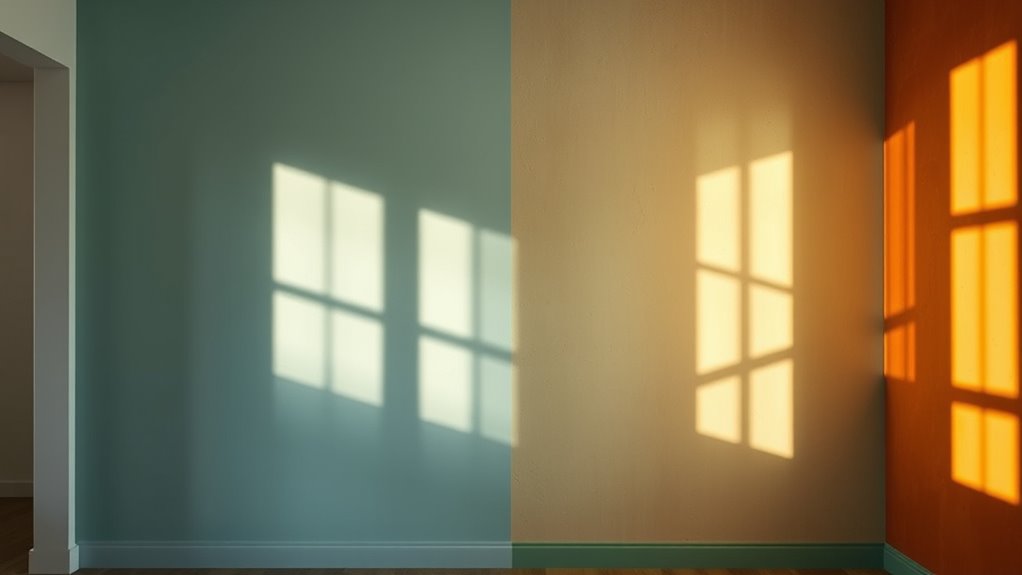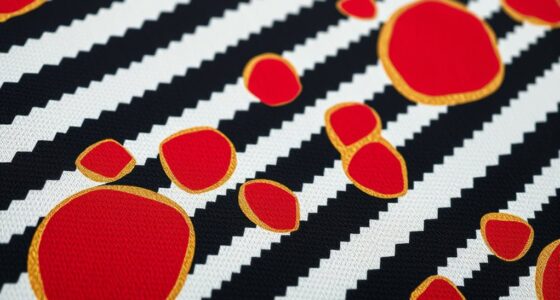Choosing cool wall colors like blues and greens can help you feel calm, focused, and relaxed, making spaces peaceful and ideal for rest or concentration. Warm tones such as reds and yellows energize you, boost motivation, and create lively, inviting atmospheres. Your mood can shift depending on the color and lighting; balancing these hues can enhance comfort or productivity. If you’re curious about how to create the perfect ambiance, there’s more to explore.
Key Takeaways
- Cool colors like blue and green promote calmness, focus, and stress reduction, ideal for relaxation spaces.
- Warm tones such as yellow and red energize, boost motivation, and create lively, inviting environments.
- Cool hues tend to evoke serenity and stability, while warm shades stimulate emotional expression and happiness.
- Lighting influences perception: warm lighting enhances warm colors’ coziness; cool lighting emphasizes cool tones’ tranquility.
- Combining both color types can balance mood, creating harmonious spaces that feel both inviting and relaxing.
The Psychological Impact of Cool Colors

Cool colors, such as blues, greens, and purples, are known to evoke calmness and tranquility. Their psychological associations often include feelings of relaxation, focus, and stability. When you surround yourself with these hues, you may notice a decrease in stress and anxiety, making them ideal for spaces meant for rest or contemplation. Cultural perceptions also influence how you interpret these colors; in many societies, blue symbolizes trust and serenity, reinforcing their calming effect. Additionally, Top Beach Towns on the East Coast often feature cool-colored decor to create inviting, peaceful atmospheres for visitors. However, it’s important to remember that individual experiences and cultural backgrounds can alter these perceptions. While cool colors generally promote peace, they might also be perceived as distant or unemotional depending on personal or cultural context. Understanding these influences helps you choose the right hues to support your desired environment.
The Energizing Effect of Warm Tones

Warm tones such as reds, oranges, and yellows have a powerful energizing effect on any space. These colors stimulate your senses and boost motivation, making them ideal for active areas. In art therapy, warm colors are used to evoke passion and confidence, supporting emotional expression. Similarly, in color therapy, they are believed to increase energy levels and promote enthusiasm. To better understand their impact, consider this table:
| Warm Colors | Effects on Mood |
|---|---|
| Red | Boosts excitement and confidence |
| Orange | Encourages creativity and warmth |
| Yellow | Inspires happiness and optimism |
| Bright Tones | Elevate energy and focus |
Using warm tones can turn your environment into a lively, invigorating space perfect for productivity and positive emotions. Additionally, incorporating electric bikes into your daily routine can boost your energy levels and promote an active lifestyle.
How Wall Colors Influence Stress and Relaxation

Your wall colors can markedly impact how relaxed or stressed you feel. Warm tones tend to reduce anxiety, while cool shades promote a sense of calm. The intensity of the color also plays a role, with brighter hues sometimes increasing stress and softer shades encouraging relaxation. Incorporating comfort solutions like soothing wall colors can enhance overall well-being in your space.
Warm Colors Reduce Anxiety
When you surround yourself with warm wall colors, you can create an environment that naturally reduces feelings of anxiety. According to color psychology, warm hues like soft yellows, gentle oranges, and earthy reds evoke positive emotional responses, fostering a sense of safety and comfort. These colors can help lower stress levels by promoting feelings of warmth and security, making your space feel inviting rather than overwhelming. Warm tones activate your parasympathetic nervous system, encouraging relaxation and reducing the body’s stress response. Incorporating these colors into your environment supports emotional well-being and helps you feel more at ease in your daily spaces. Additionally, choosing balanced diet and regular exercise can further enhance your overall mood and stress resilience.
Cool Tones Promote Calm
Cool wall colors like soft blues, gentle greens, and muted grays are known for their calming effects, helping to reduce stress and promote relaxation. In an art gallery, these colors create a serene atmosphere that allows visitors to focus and feel at ease. Similarly, outdoor landscaping featuring cool tones can foster tranquility in your space, making it a perfect retreat from daily chaos. When you incorporate these hues into your environment, you encourage a sense of calm that can ease tension and improve mood. Whether in a living room or a quiet courtyard, cool tones help you unwind and feel more centered. Their soothing qualities make them ideal choices for spaces designed for relaxation and mental clarity. Additionally, implementing space organization techniques can enhance the overall sense of calm by reducing clutter and creating a more peaceful environment.
Color Intensity Affects Stress
The intensity of wall colors can substantially impact your stress levels and overall sense of relaxation. High color saturation and sharp color contrast often lead to increased stress, making a space feel overwhelming. Conversely, softer, muted tones with lower saturation promote calmness and reduce tension. Bright, highly saturated colors can stimulate your senses and elevate anxiety, while subdued shades help you unwind. Additionally, choosing colors that complement the overall farmhouse bedroom design can enhance the cozy atmosphere and support relaxation.
Choosing Colors for Different Room Purposes

Choosing the right wall color depends heavily on the room’s purpose, as different hues can influence mood and functionality. For a relaxing bedroom, opt for soothing cool colors like soft blues or gentle greens that promote calm. In contrast, warm tones like yellows or warm neutrals energize a space like the kitchen or home office. Staying current with interior design trends helps you select colors that feel modern and stylish. Additionally, understanding paint application techniques guarantees your chosen colors look their best and last longer. For example, matte finishes create a cozy feel, while semi-gloss adds a clean, reflective surface ideal for high-traffic areas. Tailoring your color choices to each room’s function enhances comfort, productivity, and aesthetic appeal. Incorporating Vetted paint options can also ensure quality and durability for your walls.
The Role of Lighting in Enhancing Color Effects

Lighting intensity can drastically change how your wall colors look, making warm tones appear more inviting or cool shades more vibrant. The color temperature of your lighting also influences the mood, with warm bulbs softening colors and cool bulbs highlighting their brightness. Understanding these effects helps you choose lighting that complements your desired color scheme and ambiance. Additionally, selecting no-sugar-added brands for beverages can promote a healthier environment and lifestyle, subtly enhancing the calming effect of your space.
Lighting Intensity Impact
Since lighting can dramatically change how colors appear, adjusting its intensity becomes essential for achieving the desired wall effect. Bright artificial lighting can make warm hues look more vibrant and inviting, while softer lighting may create a calming atmosphere. Natural light varies throughout the day, influencing how cool or warm colors are perceived; a sunny room enhances warm tones, whereas overcast conditions soften cool shades. Increasing light intensity can brighten muted colors, making them pop, but too much glare may wash out subtle tones. Conversely, dimmer lighting emphasizes cozy, subdued moods, especially with warm walls. By controlling artificial lighting and appreciating natural light’s changing qualities, you can optimize your wall colors to evoke the perfect ambiance. As a Best Vacuum Expert, I also recommend considering the overall environment—like lighting and air quality—to create a space that feels both inviting and comfortable.
Color Temperature Influence
The color temperature of your lighting plays a crucial role in how wall colors are perceived and can dramatically enhance their effects. Warm lighting tends to bring out cozy, inviting tones, making warm wall colors feel even more comforting. Conversely, cool lighting accentuates the crispness of cool hues, creating a fresh and modern ambiance. When selecting lighting, consider how it interacts with your wall color and your desired mood. Proper lighting also influences wall color durability, as certain temperatures can make paint appear faded or uneven over time. Additionally, using appropriate paint application techniques ensures the color’s true vibrancy and consistency under different lighting conditions. Understanding city dynamics can help you choose lighting options that complement your specific environment, enhancing the overall aesthetic. Ultimately, adjusting your lighting can optimize color effects, emphasizing the warmth or coolness of your walls and improving overall room aesthetics.
Combining Cool and Warm Hues for Balanced Environments

Blending cool and warm hues creates a harmonious environment that feels both inviting and balanced. By using complementary color schemes, you can achieve striking yet cohesive spaces. Color blocking techniques help you define areas without overwhelming the senses, creating visual interest. To create balance, consider pairing soft blues with warm terracotta or gentle yellows with cool grays. Incorporate accent walls or accessories to emphasize these contrasts subtly. Mixing these hues energizes a room while maintaining tranquility. Keep in mind that the key is moderation—too much of one can overpower the other. Use natural light to enhance the effect, and experiment with placement to find what feels most inviting. Additionally, understanding color psychology can help you select hues that evoke the desired mood and atmosphere in your space. This approach ensures your space remains lively, balanced, and deeply personalized.
Tips for Selecting the Right Wall Color to Match Your Mood

Choosing wall colors that reflect your mood can transform a space into a personal sanctuary. To do this effectively, consider color psychology and how different hues influence your emotions. Warm colors like reds and oranges energize and create a cozy atmosphere, ideal if you crave motivation or comfort. Cool colors such as blues and greens promote calmness and focus, perfect for relaxation or concentration. When selecting a color, think about what mood you want to cultivate and how it aligns with your interior decorating style. Test small patches before committing to a color, and observe how the space feels at different times of day. Additionally, understanding the influence of automation in business can help you create environments that foster productivity and well-being. By intentionally choosing shades that resonate with your emotional needs, you craft environments that truly enhance your well-being.
Frequently Asked Questions
How Do Cultural Differences Influence Perceptions of Cool and Warm Colors?
Cultural differences greatly influence how you perceive cool and warm colors through cultural symbolism and regional preferences. For example, in Western cultures, red (warm) symbolizes passion, while in China, it signifies luck. Similarly, blue (cool) may evoke calm in Western societies but be associated with mourning in some Middle Eastern regions. Your perception of color is shaped by these cultural cues, impacting your emotional response and preferences.
Can Wall Colors Affect Children’s Emotional Development and Behavior?
Wall colors can influence children’s emotional development and behavior through color psychology. Bright, warm colors may boost energy and creativity, while cool shades promote calmness and focus. By choosing appropriate wall colors, you help support emotional regulation, making it easier for kids to manage feelings and stay attentive. Be mindful of individual preferences and cultural influences, as these factors also shape how children respond to different colors in their environment.
Are There Specific Color Combinations That Promote Productivity or Creativity?
Think of color pairing like a symphony—each note, or hue, works together to create visual harmony. Bright, contrasting colors like yellow and blue boost productivity by energizing you, while soft, complementary shades like green and lavender spark creativity. You can promote both by carefully selecting combinations that balance stimulation and calm, helping your space become a hub of focus and innovation.
How Do Different Lighting Conditions Alter the Perceived Warmth or Coolness of Colors?
Lighting effects and color temperature greatly alter how you perceive wall colors. Warm lighting enhances warm tones, making them feel cozier and more inviting, while cool lighting emphasizes cool hues, creating a calm or sterile atmosphere. As you change lighting conditions, the perceived warmth or coolness of colors shifts, impacting your mood and the room’s ambiance. Pay attention to lighting effects and color temperature when choosing wall colors to achieve your desired atmosphere.
What Are the Environmental Impacts of Choosing Certain Wall Paint Colors?
Choosing wall paint colors can impact the environment by influencing sustainability and VOC emissions. Light, eco-friendly paints reduce harmful VOCs, supporting better air quality and lowering pollution. Warm colors often require more pigment, potentially increasing emissions, while cool tones may use fewer resources. By selecting environmentally sustainable paints, you help minimize ecological footprints and promote healthier indoor air, making your space both beautiful and eco-conscious.
Conclusion
Your walls are more than just colors; they’re the canvas of your mood and spirit. Choosing cool or warm tones is like planting seeds—each color nurturing different feelings within you. When you blend these hues thoughtfully, you create a sanctuary that reflects your inner balance. Remember, your space mirrors your soul—let your walls whisper stories of calm or energy, guiding you toward harmony and peace in every moment you spend within.










